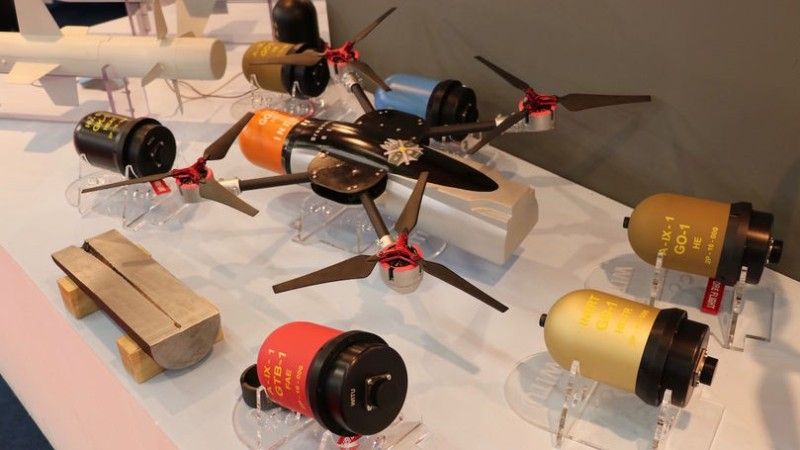Polish Warheads for Loitering Munitions

In recent years we could have witnessed a dynamic development of UAV systems, UCAVs in particular. The increased demand for systems as such also stimulates developments in the defence industry, both when it comes to UAVs, as well as warheads for unmanned applications. The Belma company, belonging to the PGZ Group, working with the Military Institute of Armament Technology, has developed a family of warheads - live and training ones - for UAVs of different classes.
Article prepared in collaboration with the Belma S.A. company
The experiences gathered during the recent conflicts in Libya, Syria, or the Nagorno Karabakh conflict (in particular), have all proven the increasing relevance of the role that loitering munitions would have on the future battlefield. The systems of this class can neutralize a wide spectrum of threats, from fighting vehicles, structures, to infantry. At the same time, they can be used for reconnaissance purposes, if the warhead is replaced with an optronic sensor. This makes UAV systems such a multi-purpose, universal asset.
The use of the loitering munitions also limits the direct involvement in the fight which, in turn, diminishes the risk of losses among the personnel. Another relevant advantage stems from the ability to mass-produce such weapons. They are also easy to employ. These features and the low price per unit make loitering munitions a sought-after product, among more and more armies around the world. A wide range of systems as such is being developed and offered, by numerous defence businesses, all over the world.

The Polish Armed Forces, specifically the Territorial Defence Component, remain one of the users of loitering munitions. The warheads for this system have been developed, and are being manufactured, by the domestic industry, namely by the Military Institute of Armament Technology and the Bydgoszcz-based Belma company.
The Military Institute of Armament Technology has developed the DragonFly quadcopter UAV system, with a range of 10 kilometers, and designed in a way that allows a single soldier to handle the system. GX-1 warheads used by the Polish military have also been a part of the aforesaid system. Back in May 2017 a license for manufacturing of the aircraft at WZL Nr 2 S.A. in Bydgoszcz was signed. The same goes for the warheads that are being manufactured by Belma.

The Belma S.A. company currently offers three families of warheads designed for UAVs. GX-1 is the first type in the catalogue. The following variants may be distinguished:
- GO-1 HE-TR training warhead that, having no explosives inside, can be used to train the operators within the scope of aiming and guidance;
- GO HE-TP training projectile has been equipped with a light 20 g load of explosives, to visualize the hit; it may be used to train the operators in aiming and engagements;
- GTB-1 FAE fuel-air explosive warhead, with 600 g explosive payload, and effective radius of 10-12 meters - it can be used to act against infantry and infrastructure inside buildings and structures;
- GO-1 HE warhead with 550 g explosive payload, and effective radius of 30 meters - it can be used to act against light armor, fortified positions, and infantry;
- GK-1 HEAT warhead, with 500 g explosive, that guarantees penetration of at least 180 mm RHA armor - it can be used against fighting vehicles and their crews. Each of the listed warheads features an optronic sensor of its own (used for target detection and guidance). Two variants of the sensor are available - one with a daytime camera, and one with a thermal imager - allowing for operations at night. Each of the warheads weighs around 1.4 kilograms.

GX-1 DG miniaturized warheads are a derivative of the GX-1 system. These weigh up to 1 kg. These feature analogous warheads, but they do not include optoelectronic systems. These warheads have been designed for Mini-UAVs that have separate observation systems, alongside the combat section. They come in four variants: GO-1 HE DG, GTB-1 FAE DG, GK-1 HEAT DG, and DG-1 HE-TR DG, with performance on par with the bigger counterparts.
Based on the experience gathered in the development of the GX-1 warheads, the Military Institute of Armament Technology also created the GX-2 family, designed for UAVs of greater payload and combat capabilities. These warheads feature a three-degree electromechanical system, and the weight went up from 1,400 to 4,800 g. The available variants are similar to the original series of warheads, but the range is greater - the thermobaric and HE warheads are effective within a radius of 50 meters. The HEAT warhead, meanwhile, can penetrate up to 700 mm of RHA.

All three families of warheads feature the SA (Safe-Arm) safety system. They can be armed and disarmed multiple times, as desired, also with the use of the operator's panel. The above means that the Belma S.A. company can manufacture warheads for UCAVs and loitering munitions made by different manufacturers, of varied payload capacity and guidance methods. The warheads are scalable, thus the whole system may be customized to meet the needs of the customer.
The loitering munitions and UAVs are becoming increasingly more relevant on the contemporary battlefield. The explosive warhead is an integral element of those systems. The warheads may be tailored to act against a variety of threats and to be carried by a myriad of platforms. As Poland owns potential within that scope, it can be far more independent in this domain.
Article prepared in collaboration with the Belma S.A. company



